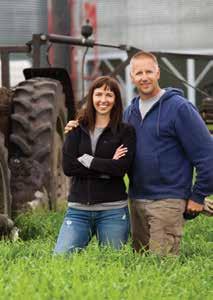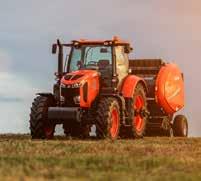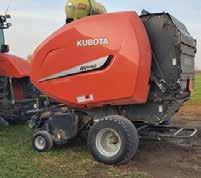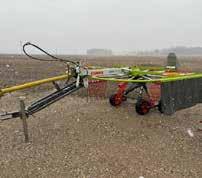




















GALEN SIMMONS
Local Journalism Initiative Reporter
For young farmers starting out, navigating the agricultural landscape and building a sustainable commodity production business can be a slow, tricky road to travel.
Just outside of Hickson in East ZorraTavistock, two young farmers – Manita and Brandon La Rose – are balancing fulltime jobs and their on-farm duties as they work to gain their footing in the poultry and beef production business at Windrose Farm.
“I grew up on a dairy farm, so I’ve always kind of been in farming,” Manita La Rose said. “Then when we got married, we got a place in town, just outside of Woodstock … right before COVID. We only had two neighbours, no one in the front and no one in the back, but after a couple of years, it’s kind of like you go home and there’s nothing to do. … It’s like there was something missing.”
Though Brandon La Rose didn’t grow up on a farm, he has farming in his genes and was raised in the country, so the pair quickly decided they wanted to return to their agricultural roots and find a property where they could have animals to take care of in the barn and enough space to grow a big garden and crops to feed them.
It took a while, but after walking away from multiple opportunities to purchase properties within their limited budget a little farther away from home, they settled on their current farm property, just 10-15 minutes down the road from the dairy farm operated by Manita La Rose’s family.
“It’s kind of central to most of the people we know,” Brandon La Rose said. “Her family farms two or three concessions over near Tavistock, so her dad can rent the land that we can’t use or haven’t grown into yet.”
“We share equipment with my dad; if he needs something planted, we’ll hop in the tractor and plant it for him with his equipment,” Manita La Rose added. “And we help out on the home farm, too, when we can, when it’s really busy.”
When they first started looking at farm properties in the area, the vision was to start their own commercial-poultry operation. While there was some support available, Manita La Rose said the startup cost for the chickens was well beyond what they could afford.
“The cost of the startup is just insane. … Usually, people have a hog operation on the side that helps pay for it to get it going. Once you get the chickens going, once you’re in, once you’ve paid off the quota, it’s a great system to be in, but it’s really hard to get into,” Manita La Rose said. “To buy a farm and build the chicken barn and buy the quota was just a lot.”
Instead, the La Roses set their sights on the Chicken Farmers of Ontario’s (CFO) artisanal chicken program, which allows small-scale producers like the La Roses

to raise larger quantities of meat chickens – between 600 and 3,000 – to sell at farmers’ markets, and to butcher shops and restaurants.
“The first year we were here, we just missed the deadline (for that program) because we closed on the farm in March and that was the due date to get into the program,” Manita La Rose said. “There’s another program called the family food program from CFO (through which) you can raise your own chickens and it’s more for your own personal consumption for family and friends. There’s more limitations to that; you can’t advertise outside of on your farm. … You can’t post on Facebook or anything like that.”
After operating in their first year under that program, the La Roses were sure poultry farming was the route they wanted to follow. With minimal renovations to the existing barn on the property – which had an insulated equipment-storage area almost perfect for brooding chickens and raising chicks – and a mobile Quonsetstyle chicken coop behind the barn that allows the couple to rotate where the chickens forage for bugs and other natural food sources, they successfully applied to the artisanal chicken program the following year and vastly increased their production capacity.
In addition to raising chickens, the La Roses also work with Manita La Rose’s father raising beef cattle.
“We butchered a cow not this past Christmas, but the Christmas before,” Manita La Rose said. “We had one lady buy a quarter cow and the rest we just pieced out to people who wanted individual cuts. Steaks and the ground beef went really quick, and then we were left with a lot of roasts. Moving forward, we’ll change gears a little bit and see if we can sell more quarter-cows and halfcows, and then we’ll try and butcher a cow
consistently every year.”
Currently, the Windrose Farm beef herd resides at Manita La Rose’s father’s Holstein dairy farm. When her father has a cow in his herd with genetics he doesn’t want for future generations, he’ll mate that cow with an Angus bull, so the resultant
calf will be part Holstein and part Angus, allowing the couple to raise it and ultimately butcher it for beef.
“He basically loans us a few cows over the summer – helps us keep the pastures – and then, if we sell one cow, two cows, whatever – they’re going to the butcher –we buy them off him at that point and the rest of the cows go back to dad’s farm and he sells them for beef at the stock market,” Manita La Rose said.
The La Rose’s already grow hay at Windrose Farms, which they use to feed their cows, and eventually they hope to have their own herd of beef cows at their farm fulltime.
“It’s nice that way because we can work with family but, at the same time, we can help each other out,” Manita La Rose said.
In looking to the future of their farm, Manita and Brandon La Rose both hope to make farming their fulltime jobs, continuing to promote the importance of buying local, and understanding and connecting to the food we eat.
By caring for the land they’ve purchased and raising their animals with both environmental sustainability and animal welfare in mind, they are doing their part in ensuring the food we eat is safe, healthy, affordable and, most importantly, 100 percent Canadian.




EMILY STEWART Gazette Correspondent
The Interfaith Counselling Centre is ready to support rural residents, including agriculture workers, and their wellbeing.
Rev. Matthew Isert Bender, executive director of the Interfaith Counselling Centre, says there are a few ways the centre supports rural residents’ mental health. The centre serves Wilmot, Wellesley and other surrounding rural communities.
“It keeps it as one of the area community’s individuals that are in the forefront for us. How are people doing? How is the rural community doing? How do we support the mental health and wellness?” Isert Bender said.
The Interfaith Counselling Centre has also been working with the Do More Ag Foundation through training initiatives such as mental-health workshops for farmers and for mental-health professionals working with those in the agriculture industry. The centre either runs the Do More Ag initiatives on their own time or with community partners like the Wilmot Family Resource Centre.
The Interfaith Counselling Centre also
Flat Storage I Bulk Trucking Buyer & Seller of Corn, Soy & Wheat


seeks out as much available grant funding as possible to provide subsidized counselling to those in financial need. The centre received a $5,000 grant from the Waterloo Community Foundation.
A 2021 National Survey of Farmer Mental Health in Canada found higher levels of anxiety, depression, cynicism, alcohol use, perceived stress and emotional exhaustion compared to the general population. The survey also found that 76 per cent of farmers reported moderate to high stress levels.
Isert Bender said both farmers and those working in agri-business deal with issues such as isolation, anxiety and financial pressures.
“There’s a lot of pressures and big numbers and also the ongoing feeling that you have those big numbers, but so many of the variables you don’t control and, if the weather’s good, it can be an amazing year’s harvest, but it can also go the other way in a lot of work done and very little return.”
Relational issues while operating a family business also come up often in counselling.
“It’s an adult child working with parents.

It’s a 60-year-old parent. ‘How do I work with my children’ or ‘how do I divide farm assets with four children, and two are farming and two are not?’ “ he said.
As someone who grew up on a farm and understands those in the agriculture industry keep communities thriving, Isert Bender wants to see more mental-health supports for farmers and those working in agri-business.
“There is a sense of responsibility to care for those who provide for us and relieve some of those pressures that are there for them, and the other thing is a need for more recognition that many are struggling,” he said. “Some of those stats raise some warning bells and alarms.”
The issue is being acknowledged federally and provincially with programs such as the Farmer Wellness Initiative, Do More Ag, and Agricultural Wellness Ontario. Mental health among farmers is also talked about more compared to 25 years ago or even 10 years ago.
“On a broader level, it is being recognized, but we need to be more intentional about caring for supporting farmers’ mental health and wellness,” Isert Bender said. Checking in with oneself as well as practicing self-compassion while struggling
can help.
“There’s no shame when one recognizes, ‘I’m not at my best. I’m so anxious or I’m depressed or I’m not sleeping well or it’s two in the afternoon and I’ve had too many drinks already,’ ” Isert Bender said.
Isert Bender also suggested those who struggling can reach out to someone for help.
“That reaching out can be a 1-800 number. It can be talking to a friend. It can be reaching out to an agency,” he said.
Those who need help but are not in crisis can call the Interfaith Counselling Centre by dialling 519-662-3092. The centre’s website, www.interfaithcounselling.ca, features a list of the following phone numbers for those in crisis:
• Suicide Crisis Helpline: 988 (Call or text)
• Huron Perth Helpline and Crisis response: 1-888-829-7484
• Kids Help Phone: Call 1-800668-6868 or text “CONNECT” to 686868
• Reach Out line for Oxford County Residents: 1-866-933-2023
• 24/7 Crisis Helpline for residents in the Waterloo Region: 1-844-437-3247
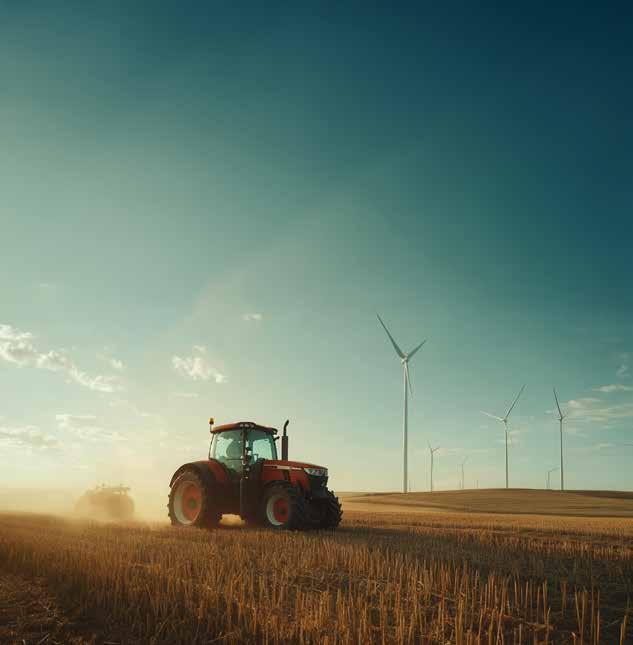





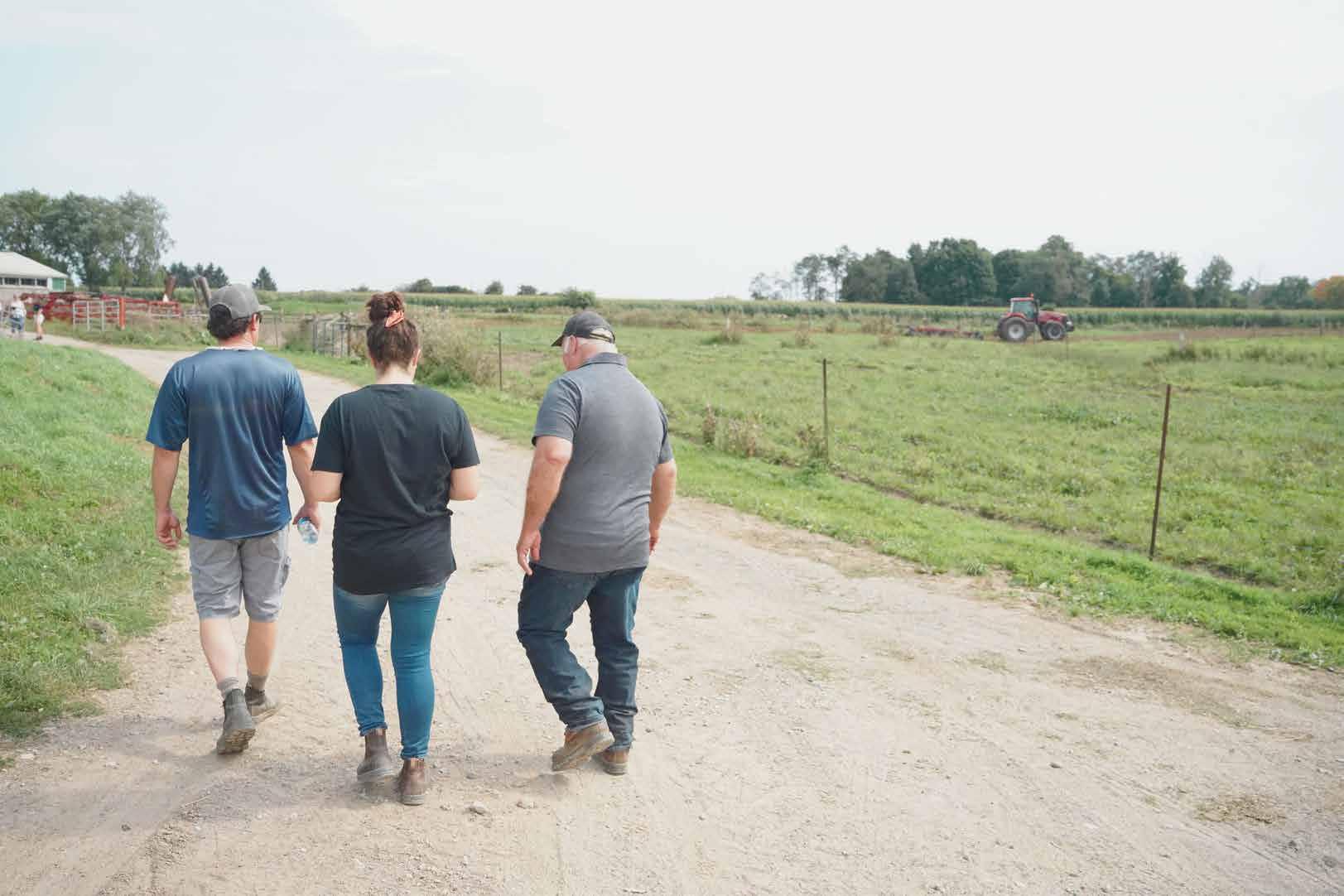



JULIA PAUL Gazette Correspondent
For more than three decades, The Best Little Pork Shoppe has been a landmark destination for pork lovers in Shakespeare.
From humble beginnings in 1987, when Linda and Gerry Knechtel started selling whole-hog sausage from their back door to its evolution into a full-fledged storefront, the shop has remained committed to quality, freshness and tradition.
Now under the ownership of Ben and Natalie Schelhaas, the shop continues to carry forward its legacy while embracing new ideas.
“We don’t sell anything we don’t like ourselves,” Ben Schelhaas said, a philosophy that has guided the business through its various ownership transitions.
Unlike many butcher shops that carry a range of meats, The Best Little Pork Shoppe specializes exclusively in pork.
From classic cuts to unique finds, customers travel from far and wide – including from the GTA – to get their hands on the shop’s signature sausage, smoked pork chops, bacon burgers and traditional offcuts like pig feet and head cheese.
“Our traditional farmer’s sausage is the best seller,” Ben Schelhaas said. “It’s made with no preservatives or fillers – just pork, salt, pepper and sugar.”


The shop’s customer base is diverse, ranging from young families using smokers for backyard barbecues to retirees looking for ready-made freezer meals. With free delivery on orders over $50 to Stratford and St. Marys, the shop is seeing a steady increase in popularity.
Consumer preferences for pork have evolved over the years. In the 1980s and ‘90s, pork was marketed as lean and comparable to chicken, but today, well-marbled pork is in high demand.
accounting, financial reporting and tax planning services for our diverse rural and urban community.
“The fat in pork is what gives it flavour,” Ben Schelhaas said. “More people are cooking it to medium-well instead of overcooking, which helps retain that moisture and taste.”
From a business perspective, Ben Schelhaas has learned a lot about butchery and consumer behaviour since taking over in 2022.
“Pork isn’t graded the way beef is, so customers need to understand the value of different cuts,” he said. “Spareribs, for
example, have more fat than back ribs, making them a better option for slow cooking.”
Ensuring quality and freshness starts at the source. The shop’s hogs are sourced weekly from local farmer Bob McMillan and processed by a local butcher.
“The pigs go to the butcher on Friday, are hung over the weekend and are cut fresh on Tuesday,” Ben Schelhaas said. “Unlike beef, which needs to dry-age, pork doesn’t require a long hang time, so our inventory is as fresh as possible.”
A pig’s diet of grains, including wheat, corn, barley and soybeans, helps maintain a neutral flavour, ensuring customers enjoy the natural taste of pork without any unwanted influences.
The pork industry has faced economic challenges over the years, from fluctuating market prices to international tariffs affecting exports. While Ben Schelhaas doesn’t experience these struggles firsthand, he acknowledges that pork farming requires resilience and adaptability.
“Farmers without contracts with slaughterhouses have struggled to stay profitable,” he said. “And with Canada being a major pork exporter, new tariffs could be a real concern for the industry.”
On the sustainability side, Ben Schelhaas has taken steps to improve efficiency at the shop. Modern refrigeration systems,
CHARTERED PROFESSIONAL ACCOUNTANTS
125 Ontario St. Stratford
Phone (519) 271-7581 Fax (519) 271-2737
E-Mail: office@famme.ca
25 Water Street North, P.O. Box 1228
St. Marys, Ontario
Phone (519) 284-1030
Fax (519) 284-4393
E-Mail: st.marys@famme.ca
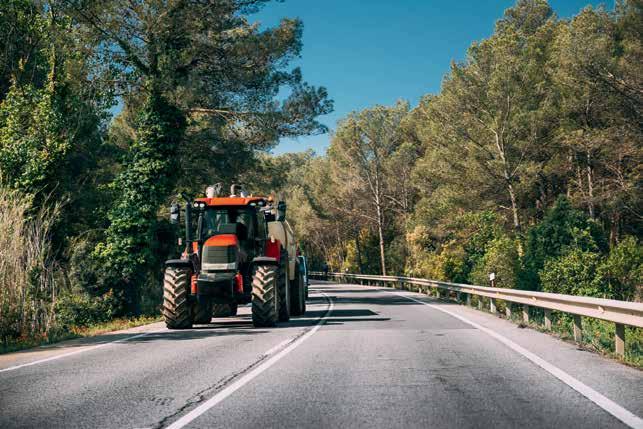
210 Oxford Street, E.
London, Ontario
Phone (519) 432-1663
Fax (519) 432-7662
E-Mail: london@famme.ca

reduced plastic use and future plans for an onsite butcher counter are part of his vision for a more eco-friendly operation.
The Best Little Pork Shoppe is constantly evolving. While pork remains the star, Ben and Natalie Schelhaas have expanded offerings to include barbecue sauces, spice rubs, locally canned goods and fresh baked items like cinnamon buns and Kaisers, using lard rendered inhouse.
“We want people to find everything they need for a great meal,” Ben Schelhaas said, “whether it’s a cut of pork, a side dish or pantry essentials.”
With an eye on the future, Ben Schelhaas envisions slowly adding more products and processes without compromising quality.
Taking over the business was a whirlwind experience.
“From the time I saw the shop was for sale to signing the deal, it was only a week,” Ben Schelhaas said.
But one of the most nerve-wracking moments came in January 2023, when the shop closed for a week-long renovation.
“I was terrified we wouldn’t get everything put back together in time,” he said.
“Thankfully, with help from my wife and dad, we pulled it off.”
Now, as the scent of smoked pork fills the air and customers arrive with smiles, Ben Schelhaas knows he made the right choice.
“Seeing people light up when they walk in – that’s what makes it all worth it.”
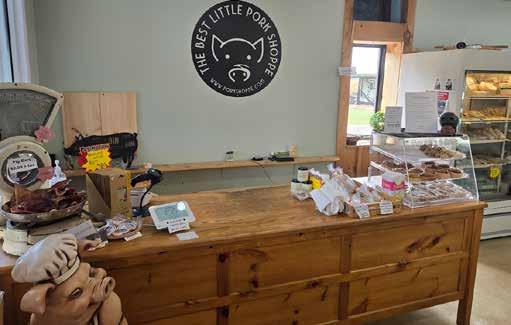


Donald Wallace Hart may not be alive to attend his induction into the Ontario Agricultural Hall of Fame, but his memory as someone who pioneered soil manage ment continues to live on.
Hart, who farmed in East ZorraTavistock, passed away in 2014 and was a leader in developing conservation tillage systems, leaving a significant and lasting impact on the quality and sustainability of Ontario farmland.
Hart’s son, Bob Hart, said he feels a sense of pride with what his father accom plished and added his pivot into cash crop ping couldn’t have been a better decision.
“I think it’s a tremendous honour and very well deserved. He was a leader in soil conservation and sustainable farm ing before sustainable farming became a common term. His father, Douglas Hart, is also in the Hall of Fame for his work in the dairy industry. My dad started as a dairy farm and hated it, so he went into beef feedlot operator before starting with cash crops,” Bob Hart said.
Donald Hart graduated from the Ontario Agricultural College in 1953 and in the 1960s, observed soil degradation caused by monoculture corn crops and moldboard plow tillage. Driven by this concern, he sought out likeminded individuals to find solutions. This group, informally known as the Oxford Group, became leaders in soil conservation in Oxford County and across the province.

he wanted to do something about it. The group of them were looking for ways to do better,” said Bob Hart.
“He was always willing to dry new and different things. He recognized that planting corn year after year after year, monoculture corn, was causing problems and
Recognizing the benefits of leaving crop residue on the surface to reduce soil erosion and build organic matter, he brought the concept back to Ontario, claiming to have performed the province’s first chisel plowing on his farm.
Throughout the 1970s and early 1980s,




Donald Hart was a sought-after speaker at farm meetings across Ontario, consistently encouraging farmers to explore new methods for improving the long-term health and productivity of their soil.
“He hosted a lot of government-type people and talked about what he was doing and why he was doing it,” Bob Hart said. “He really enjoyed working with young farmers who had questions and were
sincerely interested. Dad always had time to talk, give different views and put some different options out there.”
Bob Hart followed in his father’s footsteps and farmed fulltime until about 12 years ago.
“My brother and I had started a seed business called Agworks. We merged with another company to form Sevita International, so I ended up working fulltime there and Doug carried on farming. His sons farm and my boys work at Sevita,” Bob Hart said.
Donald Hart’s farm was located at the current Sevita, north of Woodstock on Highway 59.
“He was a humble guy. He was never one to jump into the limelight, but he was always happy to share if somebody was interested,” Bob Hart said. “He was very concerned about the long-term viability of cash-crop farming in Ontario. I think he absolutely made a difference.”
Bob Hart added chisel plowing became one of the main practices for a long time in the province.
“Maybe not so much anymore; it’s kind of moved on a little bit. But it was the big thing for a long time, and he was largely responsible for getting it going,” he said.
Donald Hart and two other deserving farmers will be inducted at a ceremony on Sunday, June 5 at the GrandWay Events Centre in Elora. More information is available at www.oahf.on.ca.
The organization’s mission is to acknowledge, record and preserve the contributions made by leaders to the growth and development of Ontario’s agriculture and agri-food industry. To date, 262 people have been inducted.




















EMILY STEWART Gazette Correspondent
Dairy farmers in southwestern Ontario can work with a specialized vet team based in Tavistock to ensure quality care of cattle and dairy production.
Tavistock Veterinarians’ dairy division provides a variety of basic and specialized vet services to dairy farmers in Tavistock and surrounding areas within a 100-kilometre radius, for optimal performance health and production health throughout the farm.
The day-to-day lives of the vets, their technicians and the rest of their team involves anything from analyzing records, vaccination protocols, ventilation work ups, cattle checkups and emergency cow services for critical emergencies.
“Our goal is to help our producers farm to the very best of their ability,” said Dr. Amanda Topp, veterinarian and owner of the Tavistock Veterinarians – Dairy Division.
When not attending to dairy farms, the veterinarian team is working on more record analysis and continuing education.


“We meet twice a month. All of us vets get together so that we’re always learning new stuff so that we can present our producers with the newest knowledge and help them keep getting better,” Topp said.
Topp is passionate about the work she does as a vet specializing in dairy livestock. Her biography on the team webpage of the Tavistock Veterinarians – Dairy Division website say she loved cattle from the time she grew up on a dairy farm in Embro.
“I personally love the dairy industry and love cattle. I love working with them. I love that I can work with dairy farmers
every day, build relationships with them and watch them succeed.”
Topp said she likes seeing the dairy farmers work towards improving their agricultural practices and collaborating with them.
“Whether it’s a management change or building onto a barn or that kind of thing, it’s great to see them build their operations and grow and continually get better as you compare year-to-year,” she said.
To learn more about the dairy division of Tavistock Veterinarians, visit tavistockdairyhealth.com.



GALEN SIMMONS Local Journalism Initiative Reporter
When it comes to promoting sustainable agriculture, a nursery in rural Wellesley township is providing the fruit trees, shrubs and bushes, and the guidance their customers need, to grow edible forests in their own backyards.
At Silver Creek Nursery, Zack and Steph Muma, their young family and their crew of six hardworking employees specialize in growing rare fruit-bearing trees, shrubs and bushes for the home gardener and anyone interested in growing their own food across the country.
“My cousin owned the business originally,” Steph Muma said. “I worked for him, but I never imagined becoming a farmer. I come at it from a food perspective. I worked in the food industry; I briefly went to Stratford Chefs School, but I dropped out. I was totally food oriented but kept being disenchanted with the food system and the industry. … When I was in high school, during summers, I would work for my cousin, who was the founder of the nursery, and then in 2018, he decided he was going to pursue his electrical career, and it was either sell it to the competition or I could take it over.”
Meanwhile, Zack Muma grew up on a mink farm. While he’d always wanted to continue in agriculture, he went to school for engineering and was working at a machine shop in Stratford prior to the offer from Steph Muma’s cousin to take over Siver Creek Nursery.
“Funny enough, (Steph’s cousin), when he started the business, it was actually two

doors down from the farm I grew up on,” Zack Muma said. “And Silver Creek actually cuts through that property (I grew up on). While Silver Creek Nursery has moved from its original location, Silver Creek actually dumps into the Nith River just across the road here, so it’s still connected.”
With more than 500 cultivars of food-bearing plants, Silver Creek Nursery offers countless varieties of apples, pears, plums, peaches, cherries, quince, medlars and apricots ranging from the traditional varieties their customers know and love to those that are far more obscure.
Nearly all of their plants are accustomed
to a Canadian climate, and the nursery also grows understory plants to round out their customers’ edible landscape including vines, berries and bushes, along with unique plants like paw paws, almonds, figs, rhubarb and various edible tubers like sunchokes.
The goal of the Mumas’ operation is to give anyone interested in sustainable, eco-friendly agriculture the opportunity to fill their fruit cellars from their own backyards.
“Everything is focused on either food-bearing or nitrogen-fixing (plants) which then helps to support the ecosystem you’re growing the fruit trees in, so




it’s self-sufficient and sustainable,” Steph Muma said. “ … I would say the driving factor is getting people to be in touch with their food and interact with it and grow it themselves. To me, the ultimate goal would be if everybody can produce at least some of their food on their own wherever they live.”
The process for growing genetically pure fruit-bearing plants differs from species to species. For apples, one of the nursery’s best sellers and the type of tree with the most varieties available, the Muma’s use a process called tree grafting in which a scion from the variety of apple tree they’re trying to grow is secured or “grafted” to the rootstock of a host tree. Over the course of two growing seasons, the Mumas and their team care for the grafted tree until the sapling is ready to be harvested in the fall of the second growing season. The Mumas then keep the harvested saplings in cold storage in their barn over winter before selling and shipping them to customers close to home and from across the country in the spring.
The Mumas also offer advice and guidance to their customers that helps them plant and care for their trees and bushes so they can survive, thrive and reliably produce fruit every season.
“We don’t use any synthetic inputs and we really focus on having a healthy plant because a healthy plant can withstand so much more. That’s our growing philosophy, so when people ask how to grow a fruit tree, there’s a holistic spray we recommend, there’s cultural practices and management, and that basically just means















providing a habitat that the tree is going to thrive in that has nature all around it. So, you’re attracting birds that help eat the bad caterpillars that would eat your fruit tree, and having a really healthy fruit tree that has such a high (sugar) content that pests can’t even digest it.
“If you have a really healthy tree, it protects itself in a way,” Steph Muma said.
For an added cost, Silver Creek Nursery will even review photos of their customers’ yards and help them design an edible forest with optimal soil, light and other environmental conditions.
Zack Muma said he and the team are constantly experimenting with best-growing practices, always with environmental sustainability top of mind. In this way, the Wellesley nursery is constantly working to ensure the trees, bushes and shrubs they sell to their customers are as strong and healthy as possible.
For more information on Silver Creek Nursery, visit silvercreeknursery.ca.















GARY WEST Gazette Correspondent
Canada’s newly appointed minister of agriculture and agri-food, Kody Blois, recently met with two influential women in Ontario’s egg industry during a meeting in Ottawa focused on key sectors within supply-managed agriculture.
The event, known as SM4, brought together representatives from the egg, chicken, hatching egg and turkey industries to engage with Blois and discuss the future of Canadian agriculture.
Among those in attendance were Perth County egg farmer Sally Van Straaten and Janelle Cardiff, who helps manage operations at Gray Ridge Egg Farms, one of Ontario’s largest egg producers.
Both women said they were impressed by the minister’s knowledge of agriculture, noting that at just 34 years old, he already has a solid understanding of the issues facing farmers and supply-managed industries.
“He was open, well-versed and focused on collaboration,” said Van Straaten.
Blois emphasized his commitment to cutting red tape, encouraging innovation and supporting sustainability in the agriculture sector. He assured those present that he intends to listen to commodity groups across the country and reaffirmed the government’s long-term support for Canadian farmers, including those operating under supply management.












GARY WEST Gazette Correspondent
In the heart of South Easthope Township, just west of Punkeydoodles Corners where Perth, Oxford and Waterloo counties meet, Julie and Ed Danen are more than just successful dairy farmers, they are passionate leaders who have helped shape the future of agriculture in their region.
Their farm, Danzel Holsteins, is home to 150 purebred Holstein milking cows and over 320 registered animals in total. In addition to caring for their herd, the Danens also farm more than 500 acres of corn, soybeans, wheat and alfalfa, and custom-feed dairy heifers for fellow producers.
But their contributions go far beyond the farm gate.
Building a farm focused on comfort and care
The Danens built a new freestall barn and milking parlour in 2008 and doubled its size in 2018, with a clear goal in mind – cow comfort.
“Our number-one priority is giving all our animals more space,” Julie Danen said. That focus on animal welfare is reflected across their entire operation, including the attention they give to maintaining their woodlots and natural areas when time allows.
Leaders in agriculture and in their community
Both Ed and Julie Danen are graduates of the University of Guelph, and both have longstanding involvement in 4-H and the Junior Farmers movement.
Julie Danen continues to serve as a


leader in the South-East Perth 4-H Dairy Club and has spent 14 years as a director with the Perth County Federation of Agriculture (PCFA), where she is now the immediate past president. She has also represented the county for 10 years on the Ontario Federation of Agriculture’s policy advisory council, including five years on its steering committee.
Ed Danen has served 12 years with the PCFA, including two as president, as well as six years on the Perth County Milk Committee. He was elected four years ago to represent the county on the Gay Lea board of directors and recently joined the Tavistock Optimist Club, where he supports local youth through club programs and initiatives.
One of the couple’s most significant community efforts was pushing for safety upgrades at the Punkeydoodles Corner intersection, a known danger zone for drivers. That project was finally completed in 2024.
A farm rooted in family
Ed and Julie Danen’s commitment to agriculture extends to the next generation. Their daughter, Rose, is a journalist working for Canada’s National Observer. Their daughter, Emily, along with her fiancé, Bray, is now managing the dairy herd and preparing to take over the farm. Their son, John, is studying computer engineering at Carleton University.
As Julie and Ed Danen continue to serve in leadership roles across the agricultural landscape, they remain grounded in their values and committed to building a better future for Ontario’s farm families.





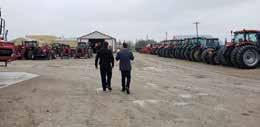








LUKE EDWARDS Gazette Correspondent
It may be an issue that needs to be on the mind of every corn grower in Ontario now, but fortunately there are ready-made solutions to the widespread arrival of tar spot.
“Really, tar spot is everyone’s problem now,” said Emma Dieleman, an agronomist with Sygenta. Dieleman was one of the presenters at the joint annual general meeting of the Niagara and Haldimand Soil and Crop Improvement Associations. She was one of several in attendance to discuss the fungal disease that has expanded to affect essentially all of the northern corn belt.
While the spread of the disease may seem concerning, Dieleman and others said there’s no need to panic.
“Management fits really well into what we’re already doing,” she said.
Existing fungicides can be quite useful, and timing of application can fit in with spraying for other fungal issues like DON, Dieleman said. And most of the time, one pass is sufficient.
Since growers south of the border have been dealing with tar spot for a decade or so, new genetics are starting to become available that will provide better resistance. Already, she said certain hybrid varieties show considerably more resistance, and Dieleman encouraged growers to consider tar spot resistance in their annual
seed planning.
“Considering tar spot susceptibility is going to be super important going forward,” she said.
The fungus was first confirmed in Ontario in 2020, but has now spread throughout the province. It can look similar to other diseases, but includes raised black lesions on the leaf surface that can’t be rubbed off. It tends to start on the lower canopy and move up.
Cooler temperatures, high relative humidity, lots of dew and saturated soils are other conditions that tar spot loves.
When those conditions are right, farmers will begin to notice symptoms within about two weeks.
“And the cycle continues as long as we have the right conditions,” Dieleman said.
However, farmers are also fortunate in that it seems as though it’s the early part of the growing season that is the most worrisome. A late infection offers limited risk, Dieleman said.
In a later Q-and-A panel, local agronomists said tar spot was one of the subjects that often came up during discussions with farmers planning ahead for 2025.
“Tar spot was part of the conversation, but it isn’t the only thing we should be paying attention to,” said Stephanie Fletcher of Twenty View Farms.
Others agreed, saying tar spot often came up in discussions, but yield continued to lead the charge.



TIM RAU Sun Life financial advisor
If you own farming or fishing property, you may benefit from unique planning strategies to help save taxes.
For example, you may qualify for lower or no taxes when you sell certain property. Or you may qualify to defer taxes on the growth if you leave certain property to specific heirs. Whether you can qualify for these tax-planning strategies is the complicated part. Life insurance can also play a critical role in your farming or fishing business succession. We discuss these strategies and more below.
Farming and fishing activities
Before reviewing the planning opportunities, the first step is to understand what farming and fishing activities qualify.
Will you benefit from tax incentives if you plant berries in your small backyard garden? Or does taking out your fishing boat twice in the summer qualify?
Not all farming and fishing activities qualify for the tax incentives. The scope and context of the farming and fishing activities affects available planning opportunities. Further, qualifying for the opportunities usually requires active farming or fishing activities for a certain length of time. Let’s look at the considerations in more detail.
Under the Income Tax Act (ITA), farming includes planting crops, raising livestock and maintaining horses for racing, and beekeeping. Fishing includes fishing for or catching shellfish, crustaceans and marine animals. Some activities may fall into both farming and fishing. For example, aquaculture, which is raising fish or shellfish in a controlled environment.
The more feeding, medication and monitoring, the more the activities relate to farming. However, the ITA definition is not exhaustive. The Canada Revenue Agency (CRA) also accepts the common, ordinary and generally accepted meaning. Despite this, the rules specifically exclude certain activities from qualifying for the tax benefits and planning opportunities.
Renting or sharecropping vs. joint venture or custom-work arrangement
Some farmers may stop personally farming or fishing and rent out property

We salute the hard work and dedication of farmers in our diverse community We thank you for ensuring we have local, healthy food on the table
or equipment or sign a sharecropping arrangement. You may consider this option as you age and have no successor or buyer for the business or property.
From a tax perspective, renting property is normally a passive activity because you’re receiving passive rental income. A sharecropping arrangement is also generally passive. Sharecropping is when you take a share of the crops instead of cash for rent. As we will see below, passive activities may disqualify you from many of the tax benefits available.
Instead, you may agree to work with another farmer or fisher, or hire someone to farm or fish using your property. This could be through a joint venture or custom-work arrangement which may qualify as active farming or fishing. Whether the CRA views the activities as passive or active comes down to the facts.
In general, to be active, you must share in the risks associated with the activities. Active involvement may include sharing expenses, making managerial decisions and retaining control over activities. Sharing in the risks involved in farming or fishing also indicates active rather than passive.
If your activities include renting or sharecropping, we recommend you speak with your external tax professionals. They can help determine the nature of your agreement and ensure you keep the tax incentives, where possible.
Business or hobby
You may partake in farming and/or fishing activities, but are the activities for business purposes, or just a hobby?
Distinguishing between business and hobby is important because only property involved in business qualify for the tax incentives. The government wants to give incentive to farmers and fishers who spend significant time and resources running their business.
The CRA publishes guides on which activities they consider indicate a business rather than a hobby. For farming, you need to actively engage in either managing the
business. They include participating in making a catch or owning or leasing a boat used to make a catch. It may also include owning licenses to make a catch or other activities.
You also need to have a reasonable expectation of profit for either farming or fishing. On the other hand, hobby activities include farming or fishing for personal reasons. Whether the CRA considers any activity a business instead of a hobby depends on your specific situation. Review with your tax and legal advisors whether your activities meet the definition for active farming or fishing activities.
Owner or operator
When planning for the tax incentives, two terms often arise: “owner” and “operator” of the farm or fishing property.
You may be the current owner and operator. However, in many farm or fishing businesses, the operator can be different from the owner. Further, many family farm and fishing businesses may change ownership or operators over the years. The ITA recognizes this and expands the normal definitions used to qualify for the tax benefits.
• Although you’re the current owner, to meet ownership time-related requirements, an owner can be you or others. This includes your spouse or common-law partner, parent, child, or a family farm or fishing partnership interest owned by you or your spouse or common-law partner. The ITA also expands child to include your child, grandchild, great-grandchild and their spouse or common-law partner. An owner can own their interest directly or as beneficial

owner through a personal trust. We define these as “eligible owner.”
• An operator can be any of the same people as an eligible owner (an “eligible individual operator”). In some cases, an operator includes a family farm or fishing corporation of these persons (together, an “eligible operator”).
This unique distinction provides flexibility for more farmers and fishers to qualify for the tax benefits below. It recognizes you may not adhere to typical ownership or use structures due to the family nature of the business. You’ll see the use of these terms as we go through the tax benefits and planning opportunities.
Further, when discussing property and its use, the CRA views “used principally” to mean more than 50 per cent of time. For example, an owner could use land for farming six years out of a total 10 years. Therefore, the owner can meet the “used principally” requirement since the farming activity represents 60 per cent of the time.
The bottom line
Tax planning strategies for farmers and fishers are complex and detailed. However, if you qualify, you can reduce and defer tax on qualified farming and fishing property for many generations.
Keep in mind, property not taxed for generations may also carry significant unrealized gains. When you or your family realize these gains, how will you or your heirs pay the taxes? We recommend discussing your options with your advisors to ensure you meet your estate-planning goals. This includes discussing life insurance as a protection for you and your farming or fishing operation.



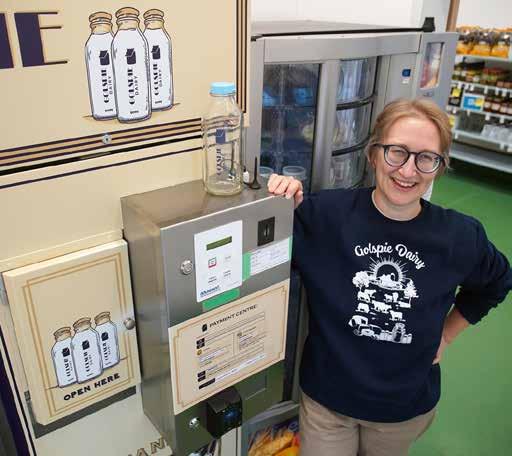
“That showed us it was a possibility here in Canada,” DeBoer-Marshall said.
There are likely less and less of us who grew up milking a cow by hand into a pail, pouring its contents through a paper filter, skimming off the cream and drinking the resultant raw milk from a pitcher.
Golspie Dairy (www.golspiedairy.ca) is providing a hyper-modern Dairy Farmers of Ontario (DFO) tested and pasteurized alternative to old-school methodology, connecting consumer to cow as directly as possible through a vending machine located on the family farming operation at 455259 45th Line, Woodstock.
“It’s a different product,” says Golspie Dairy’s Marja DeBoer-Marshall. “Something you can’t find in the grocery store.”
DeBoer-Marshall was taking political science and global affairs when she met her future husband, Laurence, at The University of Waterloo – he was studying biology. Their decision to return to his fifth, now sixth-generation family farm necessitated a career reassessment and financial discussion. Against the cost of expanding beyond its existing 30-cow milking herd, they instead diversified with an on-farm dairy combining award-winning cheesemaking and a vending machine dispensing whole milk instead of drinks or snacks. They had been exposed to the concept during visits to European farms, further research revealing there were a few in BC and one in Cape Breton.
Their Brunimat dispenser is manufactured in Switzerland, shipped to Canada through a supplier in the Netherlands. The concept is fairly simple, says DeBoerMarshall, essentially a big refrigerator with pumps and an agitator to regularly mix milk, ensuring consistency throughout, rather than the cream rising to the top. While she considers the Canadian dairy system continues to provide the best milk in the world, the Golspie approach offers a whole-milk alternative with associated content, texture and flavour benefits.
“It adds more body to the milk.”
The milk is sourced from their own farm, meeting requirements around the transportation of raw product requiring verification and samples for testing and quality assurance through the Dairy Farmers of Ontario milk marketing board.
“It ensures food safety is up to snuff and consumers are protected,” says DeBoer-Marshall.
Heated to complete the pasteurization process, milk is then chilled to four degrees Celsius. Golspie’s self-serve area is open daily from 10 a.m. to 8 p.m. A payment control on the front of a dispenser accepting coins or tap-enabled debit and credit cards allows customers to make their purchase. A second vending machine which accepts coins, $20 bills and tap-enabled debit and credit cards contains assorted Golspie Dairy cheeses, extra bottles and caps, and pre-filled bottles of
chocolate milk.
Consumers seeking milk place their own reusable container, or one from Golspie, into position, choosing between one-quart (946 millilitre) or one-gallon (3.78 litres) fills at $3 and $10 respectively. Originally, the dispenser was set up for one quart white or chocolate options. However, consumer preferences for all-white in different volumes encouraged a transition in March 2024.
“We had customers who like to get a large volume of milk at one time,” DeBoerMarshall said, adding that while having a preliminary business plan is essential, it must also be subject to demand. “You have to be flexible enough to respond to these changes.”
After each sale, an automatic wash function cleans up any spillage.
“The dispenser is smart enough to keep itself clean.”
Customers come regularly from as far away as London and the KitchenerWaterloo area, says DeBoer-Marshall, though she noted a majority are within a 10-15-minute drive.
Golspie Dairy recognizes the value of digital marketing in a modern world.
“We do some online advertising with keywords,” she said, describing the investment pushing them toward the top of the page should someone happen to search “fresh milk,” for example. There is also benefit in producing a unique offering, which, for those who like it, tend to like it a lot and share their enjoyment through
word of mouth.
“Honestly, that’s the best kind of advertising, when people love your product and want to tell other people about it,” said DeBoer-Marshall. “You can’t pay for that quality of advertising.”
There is no single easily identifiable demographic among their clientele. Some may pick up a quart or two a week, others a significantly larger amount. Many drink the milk, but there is also a percentage who prefer this option for making yogurt or cheese.
“It’s been really interesting to talk to them and ask what they use the milk for.”
Direct customer contact is among the most rewarding aspect of taking their business in a new direction, even on the rare occasions the feedback is negative.
“You can figure out a better product and better ways of doing things.”
Overwhelmingly, reaction has been extremely positive. DeBoer-Marshall considers cheesemaking awards from this year’s Royal Winter Fair among indications they are on the right track, along with customer loyalty, enthusiasm and feedback. The latter has also provided a far-more intimate connection to the far-reaching impact of a single Canadian farm, even from what the dairy industry would consider a small operation.
“Our little farm feeds a lot of people,” DeBoer-Marshall said. “It’s not just for us and the cows; it touches a lot of lives every day.”











DIANE BALTAZ Gazette Correspondent
Two federal bills that recently received royal assent restore Canadians’ right to repair their own equipment, including tractors and combines.
On Nov. 7, 2024, Bills C-244 and C-294 – the two bills intended to amend Canada’s Copyright Act – received royal assent. These changes to the act allow circumvention of technological protection measures (TPMs) or “digital locks” in order to allow faster diagnosis, maintenance, repair and interoperability of Canadians’ technological tools, including the right to obtain parts from other companies.
Various lobby groups from across Canada, including the Ontario Federation of Agriculture (OFA), laud these bills as a critical step towards Canadian agriculture’s innovation and sustainability.
Bill C-244, introduced in 2022 by Wilson Miao, the Liberal MP for Richmond Centre in BC, allows consumers and businesses to bypass TPMs such as encryption and password locks to access electronic components without having to travel to a dealership for repairs.
Bill C-294, introduced by Jeremy Patzer, Conservative MP for Saskatchewan’s Cypress Hills-Grasslands, focuses on the interoperability of different computer programs or devices in which they are
embedded, including the right to purchase parts from other brands without violating copyright laws.
Simply put, this means farmers can repair their equipment more easily without being forced to pay authorized dealers to diagnose and repair equipment, often at the additional cost of long waits. Equipment breakdowns became particularly detrimental during harvest periods, resulting in lost productivity.
“This is great,” said Brant-HaldimandNorfolk OFA director Larry Davis of Burford. “We (OFA) have been asking the government for legislation that lets people make their own repairs and run diagnostics without having to travel to a dealership. We want to fix things on our own farms ourselves right now, compared with waiting a week or two for a dealership to fix equipment, especially in the middle of harvest.
“With interoperability, instead of taking my equipment to one colour machine dealer, I can now take it to another colour. We really need to try to work on repairs ourselves, on our own farms.”
Proponents such Western University’s assistant professor Alissa Centivany lauds the new laws’ benefits, including better longevity and care of equipment, minimized waste, improved farm productivity and Canadian food security.
Centivany has researched technology
and copyright issues for decades. She co-founded the Canadian Repair Coalition (CanRepair) and testified on copyright’s impact on right-to-repair at parliamentary committees. She uses what she calls the “Three Cousins” to address systematic issues around consumer products: reparability, interoperability and durability.
While Bills C-244 and C-294 deal with copyright’s impact upon digital encryption on multiple products, Centivany’s advocacy focused on the misuse of copyright to stop repairs that can be done by equipment owners or local mechanics. She said she entered her work “through the farmer portal.”
“Farmers kicked it off – they need credit as they pushed this issue forward,” she said. “It began with the USA farm movement. It went before state and federal legislatures and resulted in memorandums of understanding, and eventually legislation in a few states.”
Centivany explained these initial gains occurred in the United States because that is where the major farm-equipment companies are headquartered. Because these companies are multinational in operation, Canadian farmers’ own advocacy gained momentum after the initial U.S. success.
This occurred around 2016, she added.
“One must ask, what has copyright to do with farming?” said Centivany. “Computer codes get treated similarly to copyright on

books, resulting in a ‘lock,’ which farmers are not allowed to break even if the repair has nothing to do with the code.
“Farmers are really sophisticated about their equipment and modifying it. We should let them keep doing what they’ve always done well.”
Though critics call these bills a good step, some advocates say standalone legislation is still needed for a more comprehensive right to repair. These include reforms in provincial consumer protection laws that require manufacturers to design products with ease of repairs without the fear of infringing upon various intellectual-property rights.
“It’s still complicated as farmers need to get the tools,” said Davis. “There are some open dealers and repair shops to get these applications. These repairs aren’t only for farmers but also for other types of equipment.”
Centivany said Canada remains behind Europe in right-to-repair issues. However, she said Quebec passed Bill 29, which protects consumers from planned obsolescence and promotes reparability and durability of goods.
She added the Ontario Legislature passed first reading on Bill 187, an act intended to protect right-to-repair items ranging from household appliances, wheelchairs and motorized vehicles including heavy farming equipment.













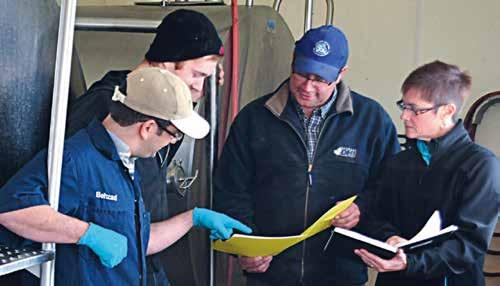
Remember
Though


– whether fresh, frozen, processed, cured or prepared into ready-made meals.
start to be available can be found at homegrownofa.ca.
In this tumultuous and uncertain environment, Ontarians can take action to make a real difference through their shopping choices.
The start of a new growing season is only weeks away, but while we wait for spring, there is still an abundance of homegrown food and farm products that make it easy to choose local – and support a strong, vibrant Ontario at the same time.
“From farm to table, when you buy local, you’re making a choice that extends far beyond the immediate satisfaction of a quality, homegrown product – you’re choosing to support Ontario, our communities and our economy,” said Ontario Federation of Agriculture (OFA) vice president Ethan Wallace in a press release. “Buying local food, flowers, fibre and fuel also supports the preservation of our farmland – our most precious natural resource and one of the strongest tools we have to bolster Ontario against the threat of international political unrest.”
Many local agricultural products are available all year long. Ontario-raised pork and beef, for example, can be found at markets, restaurants, stores and even online delivery services province-wide
Other products that are always in season? Think most root vegetables, meat and poultry, fish, eggs, dairy, wines and craft beverages, greens, honey, and greenhouse vegetables.
Greenhouses are also the year-round source of fresh Ontario potted plants and flowers, tulips, freesias, gerberas and more. More than 70 per cent of Ontario’s flower production is exported to the United States, with almost 40 per cent of those sales taking place between March and May. This year, support the more than 200 Ontario flower greenhouses and their 9,000 workers and make your flower choice a local one.
March is typically when the sap starts flowing in maple trees, and that means Ontario sugarbushes and farm-made maple syrup. A cold, snowy winter raises expectations of a good year for Ontario’s maple syrup producers. Find one near you at ontariomaple.com.
The OFA’s Home Grown campaign raises awareness of the importance of preserving Ontario farmland for the production of food, fuel, flowers and fibre. Regular updates on products grown and raised in Ontario and when this year’s harvest will
“As we celebrate the arrival of spring, let’s take this opportunity to renew our commitment to Ontario food and farming,” added Wallace. “Our choices matter, and by making a conscious effort to buy local, we are supporting our province, our communities and businesses, and our economy at a time when it’s needed most.”

We’ve been insuring farms for generations, providing excellent service and local know-how. We know the special demands of the area, and we’ll be there if you have a claim. We live here and we work here - local starts with mutual insurance.
Contact us today and discover the mutual difference!
usborneandhibbert.ca1-800-422-3996
